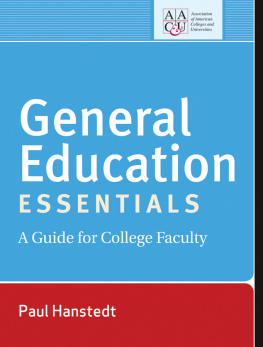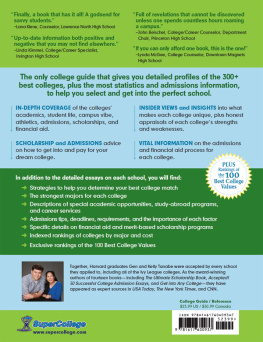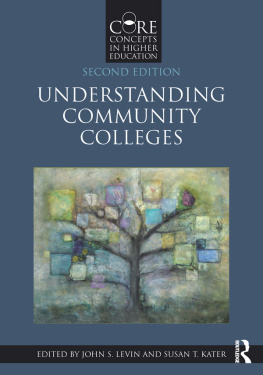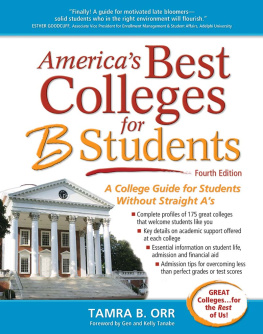How to Run a College
How to Run a College
A Practical Guide for Trustees, Faculty, Administrators, and Policymakers
Brian C. Mitchell
and
W. Joseph King
Johns Hopkins University Press Baltimore
2018 Johns Hopkins University Press
All rights reserved. Published 2018
Printed in the United States of America on acid-free paper
9 8 7 6 5 4 3 2 1
Johns Hopkins University Press
2715 North Charles Street
Baltimore, Maryland 21218-4363
www.press.jhu.edu
Library of Congress Cataloging-in-Publication Data
Names: Mitchell, Brian C., 1953 author. | King, W. Joseph, author.
Title: How to run a college : a practical guide for trustees, faculty, administrators, and policymakers / Brian C. Mitchell, W. Joseph King.
Description: Baltimore, Maryland : Johns Hopkins University Press, [2018] | Includes bibliographical references and index.
Identifiers: LCCN 2017025727| ISBN 9781421424774 (pbk. : acid-free paper) | ISBN 9781421424781 (electronic) | ISBN 1421424770 (pbk. : alk. paper) | ISBN 1421424789 (electronic)
Subjects: LCSH: Universities and collegesAdministrationHandbooks, manuals, etc.
Classification: LCC LB2341.M545 2018 | DDC 378.1/01dc23
LC record available at https://lccn.loc.gov/2017025727
A catalog record for this book is available from the British Library.
Special discounts are available for bulk purchases of this book. For more information, please contact Special Sales at 410 -- 6936 or specialsales@press.jhu.edu.
Johns Hopkins University Press uses environmentally friendly book materials, including recycled text paper that is composed of at least 30 percent post-consumer waste, whenever possible.
To our wives,
Maryjane and Leigh, who make big ideas seem like an adventure worth taking
Contents
Preface
In 1934, J. H. Reynolds, president of Hendrix College, wrote in the New York Times , America has perhaps 400 small colleges. A reduction of this number to one-third would undergird and strengthen American higher education, giving solidarity, power, and higher standards.
In 2016, there were almost 4,000 nonprofit institutions in the United States with significant variations in type, Our decentralized higher education community is awash with problems and in the throes of significant change. Yet this is a seminal moment in its development.
Colleges are confusing, bewildering, and complex places with storied traditions, antiquated governance practices, and competing constituencies. Even worse, however, is that many of the key leadership groupsespecially trustees but including faculty and senior staffare ill equipped to advise and govern a modern college or university. The end result is an erosion of good will among key stakeholders, often leading to institutional inertia, and in the extreme, debilitating chaos. These glaring internal inefficiencies, communication breakdowns, and the overriding sense of cultural inertia on many campuses are also set against a backdrop of changing consumer preferences, high sticker prices, declining demand, massive tuition discounting, aging infrastructure, technological and pedagogical alternatives, and state and federal political pressures.
That having been said, the American residential college to which President Reynolds referred in 1934 remains the foundation upon which other higher education sectors are based, including modern research universities, especially at the undergraduate level. It can be resilient under able leadership.
When we met at a conference of private college and university presidents in Fort Worth several years ago, we were both startled at the similarities in our views on the future of American higher education. As our discussions deepened, we decided that it was important to put our thoughts on paper. We agreed that these thoughts would be tied to the historic foundation upon which higher education is built. They had to convey with considerable urgency that colleges and universities must look past the way that they have always operated. We determined that the sky is not falling but that the pressure placed upon higher education to change and adapt has never been greater.
We wrote this book as an exercise through which to imagine the possible. We knew that the key to unlock the collective wisdom of the change agents and thought partners spread across higher education was not found in recently published monographs, although there are some good books available. This was new territory since most recent literature focuses on process, the types of transformation, ideology, and the programs or the tactics. While we cite our sources with considerable care, much of what we believe comes from the experiences that we have shared, the training of our mentors, and the wisdom of committed colleagues. We trust that the end result is a thoughtful and candid assessment of what to do to move Americas colleges and universities through the twenty-first century.
In this book, we offer an optimistic assessment based upon frank and stark conclusions about what colleges must doand not doto remain relevant in the twenty-first century. We look not only at how they can survive but also at why they must survive. We begin with a fundamental premise, namely, that colleges and universities must evolve and adapt by modernizing their practices, monetizing their assets, focusing on core educational strategies, and linking themselves explicitly to the modern world.
President Reynoldss argument is a challenge to American higher education. No longer can colleges operate behind their college gates in a world they wish actually existed. We offer an analysis of how these colleges operate, what works, and what must change.
Acknowledgments
There are many individuals to thank. At the top of the list is our research assistant, Jodi Reeves Eyre. Jodi is an accomplished sleuth who understands the bigger questions and appreciates complexity and subtlety. Jodi is diligent and purposeful and has a remarkable ability to mediate the conversation between us when we disagree over topic, method, or approach. She is resourceful and has a remarkable sense of humor, which served our writing well. The book is better and more focused thanks to Jodis persistence and hard work.
Both of us have been blessed through the kind and patient mentorship that we have enjoyed throughout our careers, especially in their early stages. Much of what we wrote is predicated upon the training and wise counsel that a large group of presidentsmany of them now retiredprovided and that subsequently shaped our views on higher education. We are especially grateful to Arthur J. Rothkopf, of Lafayette College, for his pragmatism, intellectual acumen, depth of knowledge, and political skills; and Jake B. Schrum, of Emory & Henry College, for his vigorous support and leadership in the world of advancement.
Added to this list of presidents are William D. Adams, Bucknell University and Colby College; Ed Ayers, University of Richmond; JoAnne Boyle, Seton Hill University (deceased); Esther Barazzone, Chatham University; Robert J. Bruce, Widener University; Grant Cornwell, Rollins College; Tom Courtice, Ohio Wesleyan University; Richard Creehan, Alderson Broaddus University; Rev. Ed Dobbins, Villanova University; Jim Douthat, Lycoming College; A. Lee Fritschler, Dickinson College; Bryon Grigsby, Moravian College; Gordon Haaland, Gettysburg College; Christopher Hopey, Merrimack College; Tom Kessinger, Haverford College; Tom Kepple, Juniata College; Richard J. Kneedler, Franklin & Marshall College; Betty Landman, Arcadia University; Peter Likins, Lehigh University and the University of Arizona; Roger Martin, Moravian College and Randolph Macon College; Charlie McCormick, Schreiner University; Mary Patterson McPherson, Bryn Mawr College; Sr. Francesca Onley, Holy Family University; Rev. Al Panuska, University of Scranton (deceased); Oscar Remick, Westminster College (deceased); Daniel F. Sullivan, Allegheny College and St. Lawrence University; Joel Thierstein, West Virginia Wesleyan College; Timothy Thyreen, Waynesburg University; and Sr. Carol Jean Vale, Chestnut Hill College.
Next page




